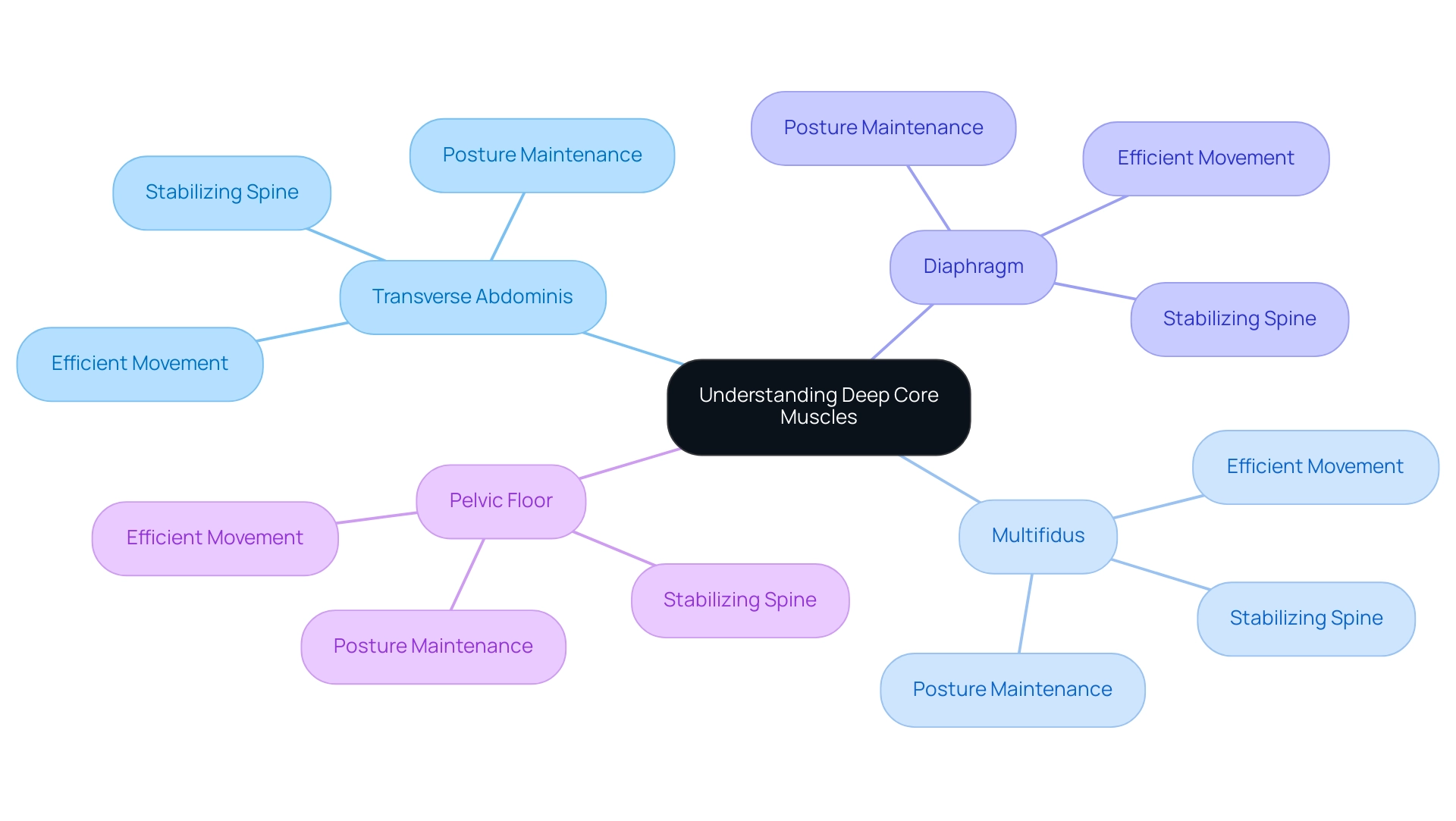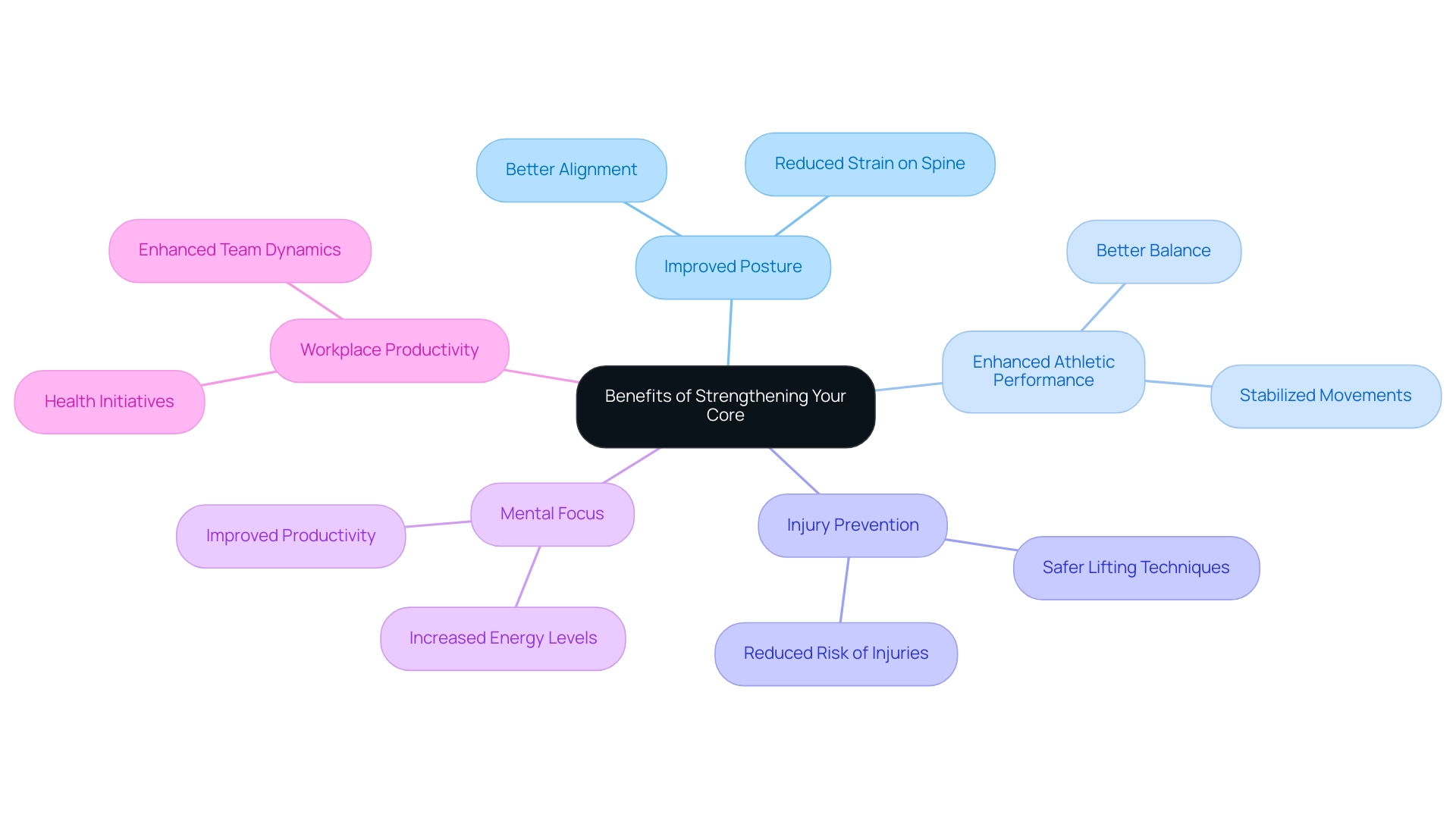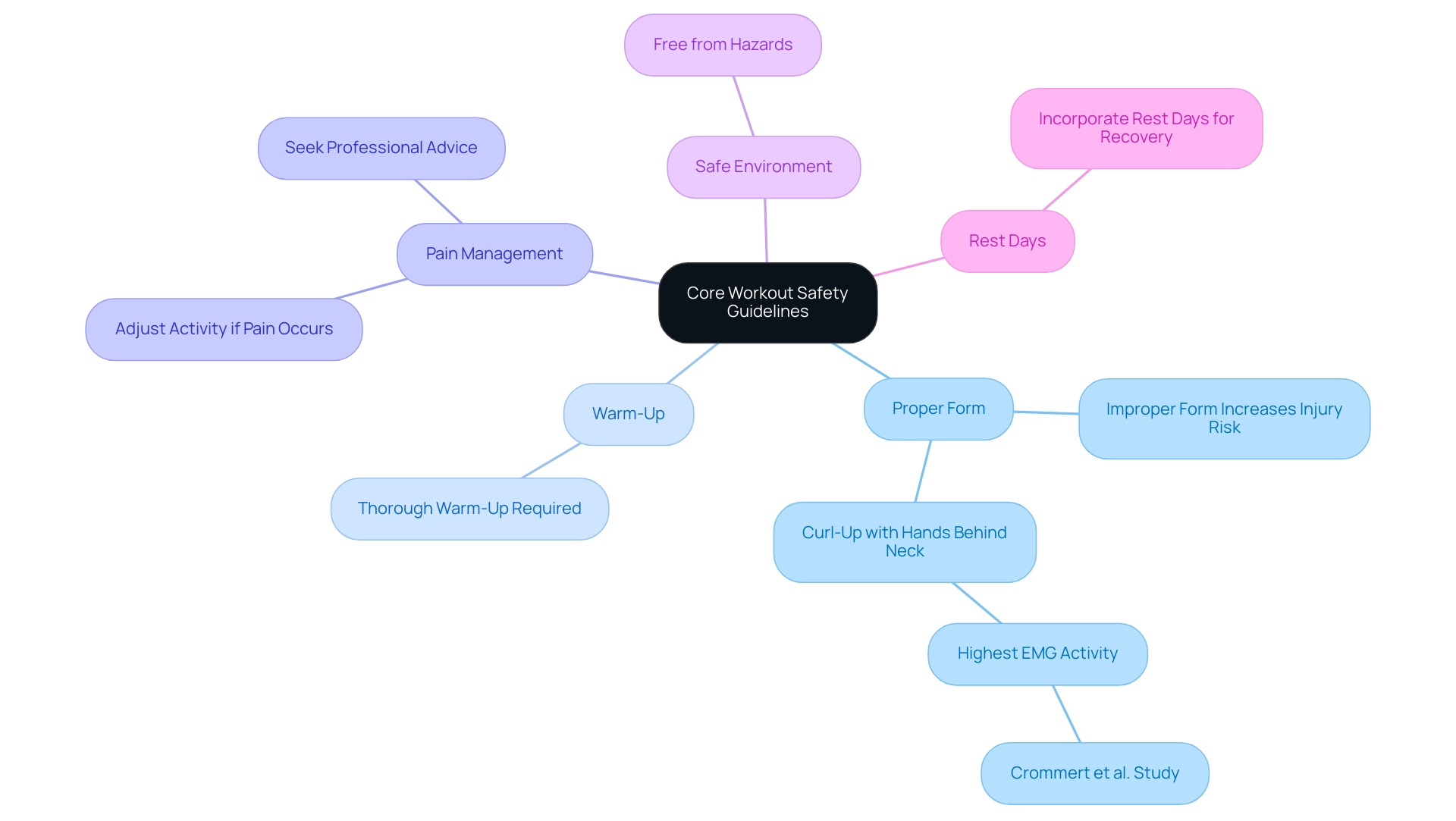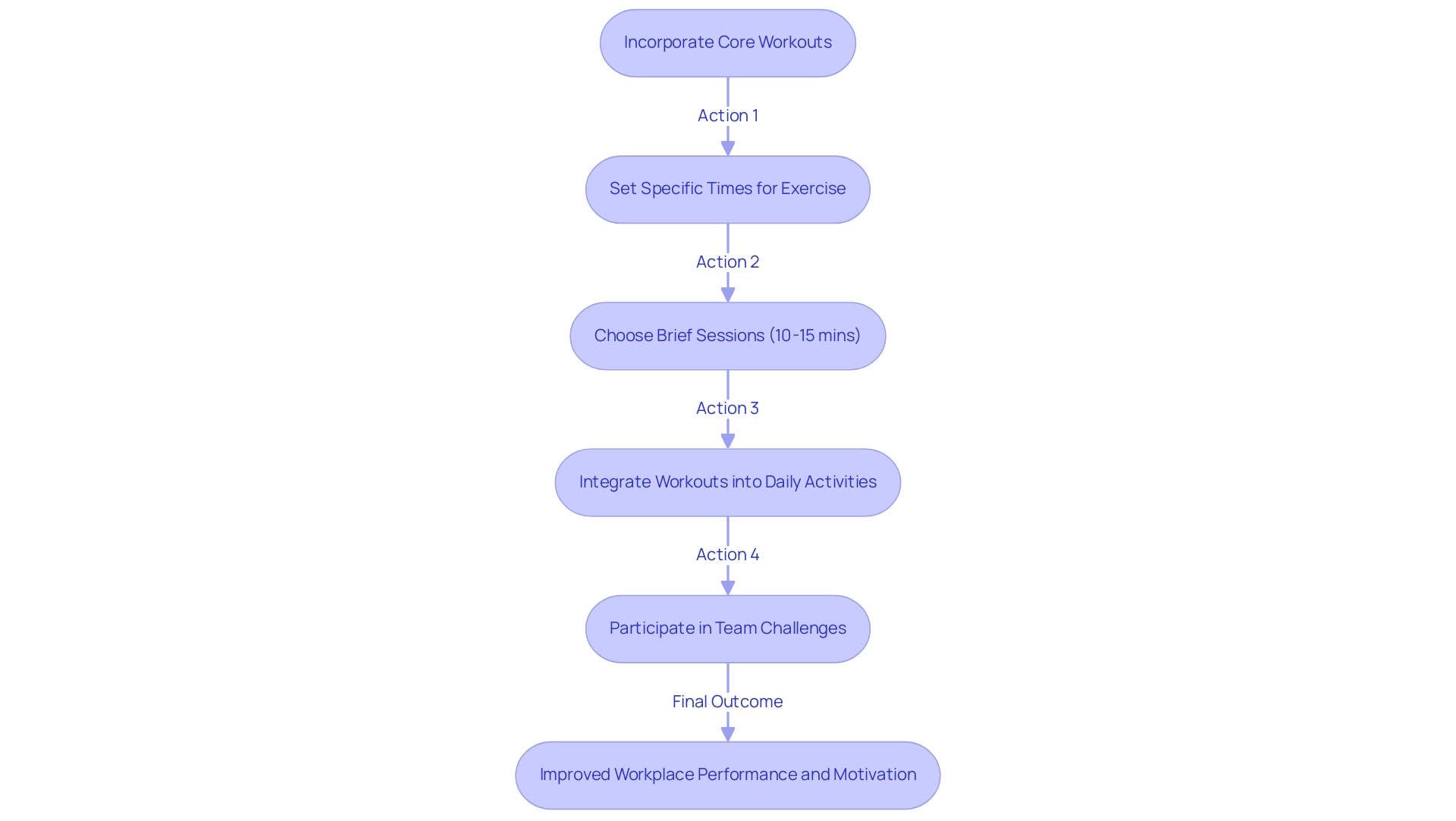Overview
Mastering deep core work involves understanding the anatomy and importance of deep core muscles, which are essential for stabilizing the spine and improving overall physical performance. The article supports this by detailing the benefits of strengthening these muscles through targeted exercises, emphasizing their role in enhancing posture, reducing injury risk, and promoting mental focus, ultimately making a strong case for incorporating deep core workouts into regular fitness routines.
Introduction
In the quest for optimal health and performance, the significance of deep core muscles often goes overlooked. These muscles, including the transverse abdominis, diaphragm, and pelvic floor, form the foundation for stability and movement in everyday life and athletic endeavors alike. Understanding their anatomy and function is crucial, as a well-developed core not only enhances posture and balance but also reduces the risk of injuries.
This article delves into the importance of strengthening core muscles, explores effective exercises from basic to advanced techniques, and offers practical guidelines for safe and effective workouts. Additionally, it highlights the necessity of tailoring core training to meet the diverse needs of different populations, ensuring that everyone can reap the benefits of a strong core as part of their health regimen.
Understanding Deep Core Muscles: Anatomy and Importance
Deep foundational structures include the transverse abdominis, multifidus, diaphragm, and pelvic floor elements, each playing a vital part in stabilizing the spine and pelvis. These tissues are crucial for maintaining proper posture and facilitating efficient movement patterns. Deep core work not only enhances balance and coordination but is also essential for carrying out daily activities and excelling in physical performance.
According to Dr. Wendi Weimar, director of the Sport Biomechanics Laboratory at Auburn University,
The central structures are essential because they stabilize the center of the body so that the tissues of the appendicular skeleton can pull against a stable platform.
This stabilization is particularly vital in workplace environments, where physical demands fluctuate. Recent research highlights that engaging these muscles through targeted movements can significantly reduce the risk of injuries, with a significant interaction effect found indicating higher mean relative thickness during the hollowing maneuver compared to bracing for all three muscles.
Additionally, the results of the case study titled 'Implications for Rehabilitation and Training' indicate that including bird dog and side plank exercises with the hollowing maneuver may improve stability and aid in recovery for individuals undergoing rehabilitation. This makes it essential for individuals to comprehend and prioritize deep core work as part of their health regimen.

The Benefits of Strengthening Your Core: Why It Matters
Enhancing your midsection provides numerous advantages that go beyond just physical fitness. Improved posture is one of the most significant advantages, as it promotes better alignment during daily activities, reducing strain on the spine. Moreover, central strength is intrinsically linked to enhanced athletic performance; studies indicate that targeted central training can improve balance, with a substantial effect size (SMD = 0.81), demonstrating its effectiveness in stabilizing movements essential for sports and daily life.
This stability not only mitigates the risk of injuries but also contributes to safer execution of tasks such as lifting and twisting. Furthermore, a robust central strength has been linked to enhanced mental focus and energy levels, leading to improved productivity in the workplace. Participating in regular foundational workouts promotes a culture of health and performance within teams, enhancing overall workplace dynamics.
As Mina Makar emphasizes, organizations that prioritize health initiatives, such as essential training, are addressing critical needs that ultimately benefit both employees and the organization as a whole. Additionally, the case study named 'Fundamental Movements: Importance and Advantages' demonstrates how foundational activities are vital for reinforcing the muscles surrounding the torso, resulting in enhanced balance and stability necessary for both athletics and everyday tasks. It is important to note that while these benefits are significant, the methodological quality of the reviewed studies was low, suggesting the need for better-designed randomized controlled trials in the future.

Exploring Core Exercises: From Basics to Advanced Techniques
To establish a strong basis for fundamental strength, it's crucial to begin with simple routines like:
- Planks
- Bridges
- Bird-dogs
These movements not only create stability but also prepare you for more advanced techniques. As you gain strength, you can incorporate challenging activities like:
- Hanging leg raises
- Stability ball rollouts
- Medicine ball slams
Each of these activities focuses on various anatomical groups, contributing to a thorough strengthening regimen. Significantly, research by Cugliari & Boccia (2017) indicates that suspended plank variations, particularly the suspended roll-out plank, elicit substantial activation of key abdominal muscles, including the rectus abdominis (RA), internal obliques (IO), external obliques (EO), and erector spinae (ES). This emphasizes the effectiveness of merging static and dynamic activities for optimal abdominal development.
Additionally, McGill & Marshall (2012) discovered that individuals aged 25.60 ± 3.40 years exhibited differing degrees of strength enhancement, highlighting the significance of customizing activities to personal abilities. As you advance, keeping proper form and control is essential; gradually raising intensity will improve your body's strength and stability effectively. Acknowledging the individual differences in workout execution, as pointed out by fitness expert Eleftherios Kellis, who mentioned, "It is important to note, however, that individual differences, proper workout execution, and other factors can influence the effectiveness of these routines," is also essential to ensuring that each session is customized to your specific needs, ultimately leading to the best outcomes.

Safety First: Guidelines for Effective Core Workouts
Prioritizing proper form during abdominal exercises is essential for maximizing effectiveness and minimizing injury risk. Research indicates that improper form can significantly increase injury rates, emphasizing the need for careful execution. In fact, studies show that a total volume greater than 16 sessions can yield an effect size of ES = 1.55, highlighting the effectiveness of consistent core training.
Begin each workout with a thorough warm-up to prepare your muscles and joints for the demands ahead. It's essential to pay attention to your body; if pain or discomfort occurs, think about adjusting the activity or obtaining professional advice. According to experts, the curl-up performed with hands behind the neck generates the highest EMG activity, as noted by Crommert et al., which underscores the importance of executing core exercises correctly.
Furthermore, maintaining a safe exercise environment—free from hazards—is paramount. Incorporating rest days into your training schedule allows for necessary recovery and muscle growth, further supporting long-term fitness goals. A systematic review titled 'Core Training and Athletic Performance' highlights the moderate and large effects of deep core work on performance variables, reinforcing the significance of proper form and adherence to safety guidelines in exercises.
Following these safety guidelines not only encourages efficient training sessions but also nurtures a dedication to injury avoidance, highlighting the significance of correct technique in fundamental movements.

Incorporating Core Workouts into Your Daily Routine
Integrating deep core work into your daily routine can be both manageable and effective with a few strategic adjustments, ultimately enhancing workplace performance and motivation. Setting aside specific times for exercise, such as early mornings or lunch breaks, helps establish a consistent routine. Choosing brief, impactful exercise sessions that last only 10-15 minutes makes it simpler to incorporate fitness into a hectic schedule.
Significantly, home exercises can save individuals up to $1,000 each year compared to gym memberships, emphasizing the financial advantages of exercising at home. Moreover, you can seamlessly integrate fundamental workouts into existing activities—performing planks while watching TV or doing seated leg lifts at your desk helps maximize your time. To further engage with colleagues and promote emotional well-being, consider initiating team challenges or group exercises, fostering a sense of community and accountability.
As noted by Saner et al., high-intensity interval exercise can effectively mitigate reductions in various physical functions and enhance employee motivation, making it a valuable addition to your routine. Research indicates that consistent engagement in deep core work, ideally aiming for core exercises at least three times a week, significantly enhances effectiveness. For instance, Sprint Interval Training (SIT), which involves short bursts of activity followed by recovery, has been shown to increase muscle endurance and insulin sensitivity, illustrating a practical application of effective short workouts.
This approach not only promotes physical health but also cultivates a supportive environment that encourages positive emotions and satisfaction among all participants. Significantly, taking part in workplace fitness programs can lead to a reduction in absenteeism and presenteeism, further enhancing productivity and engagement. Therefore, aiming for at least 30 minutes of physical activity three times a week can significantly contribute to overall employee motivation and emotional well-being.

Tailoring Core Strengthening for Different Populations
Tailored approaches to deep core work are essential for various populations, particularly postpartum women and athletes. For postpartum women, gentle activities that focus on rebuilding strength and stability, such as pelvic tilts and modified planks, are crucial. These activities not only aid recovery but also enhance functional capacity.
In contrast, athletes require more sophisticated training routines that enhance their specific sport performance, incorporating rotational movements and explosive exercises that are integral to their training regimens. The Essential Coaching Plan, priced at just $67/month, offers affordable, curated workout programs designed to meet these diverse needs, providing both postpartum women and athletes with structured yet flexible options. The rising interest in flexible fitness options is clear from the 46% surge in fitness app downloads during the COVID-19 pandemic, highlighting the significance of adaptable training programs.
Additionally, a recent study concluded that customized strength exercises (CSE) are superior to both IDBE and Control groups, indicating clinically relevant improvements in functional disability and endurance. This evidence reinforces the need for assessing individual needs and fitness levels when designing fundamental programs, ensuring that all participants feel included and supported in their fitness journey. The IHRSA states that 80% of fitness enthusiasts favor a hybrid approach combining home workouts with occasional gym visits, further emphasizing the flexibility needed in essential training.
The Essential Coaching Plan's interactive app facilitates stress-free management of these programs, allowing users to personalize their fitness journey effectively. With goal-oriented choices that include Muscle Gain, Weight Loss, Endurance, or Overall Fitness, and experience level options from Beginner to Advanced, the plan accommodates varying employee availability and fitness levels. Collaborating with fitness professionals can enhance the effectiveness of these tailored programs, ensuring they are not only practical but also aligned with the latest evidence-based practices.
This commitment to customization is essential in delivering impactful solutions for deep core work.

Conclusion
Deep core muscles play a pivotal role in overall health and performance, underscoring their importance in daily activities and athletic pursuits. By understanding the anatomy and function of these muscles, individuals can appreciate how a strong core enhances stability, improves posture, and mitigates the risk of injuries. The article highlights a range of effective exercises, from foundational movements to advanced techniques, emphasizing the need for tailored approaches based on individual capabilities and needs.
Strengthening the core yields multifaceted benefits, including improved athletic performance and mental focus, contributing to better productivity in various aspects of life. By incorporating core workouts into daily routines, individuals can seamlessly integrate fitness into their busy schedules, fostering a culture of health and well-being. Additionally, prioritizing safety and proper form during these exercises is crucial for maximizing effectiveness and minimizing injury risk, reinforcing the importance of mindful training practices.
As the article concludes, tailoring core strengthening programs for different populations, such as postpartum women and athletes, ensures that everyone can access the benefits of a strong core. Emphasizing customization and flexibility in training regimens not only enhances individual outcomes but also promotes a supportive fitness environment. Ultimately, prioritizing deep core training is essential for anyone looking to enhance their physical health and performance, making it a vital component of a well-rounded health regimen.
Frequently Asked Questions
What are the deep foundational structures involved in core stability?
The deep foundational structures include the transverse abdominis, multifidus, diaphragm, and pelvic floor elements, all of which are vital for stabilizing the spine and pelvis.
Why is deep core work important?
Deep core work enhances balance and coordination, is essential for daily activities, and improves physical performance by maintaining proper posture and facilitating efficient movement patterns.
How do deep core muscles contribute to injury prevention?
Engaging deep core muscles through targeted movements can significantly reduce the risk of injuries, especially in fluctuating physical demands, by stabilizing the center of the body.
What exercises are beneficial for improving stability and aiding recovery?
Exercises such as the bird dog and side plank, combined with the hollowing maneuver, may improve stability and aid in recovery for individuals undergoing rehabilitation.
What are the benefits of enhancing midsection strength?
Enhancing midsection strength leads to improved posture, better alignment during daily activities, reduced strain on the spine, improved athletic performance, and increased mental focus and energy levels.
How does central strength affect workplace productivity?
A robust central strength contributes to safer execution of tasks and has been linked to improved productivity in the workplace by enhancing mental focus and energy levels.
What does the case study 'Fundamental Movements: Importance and Advantages' suggest?
The case study indicates that foundational activities are crucial for reinforcing the muscles surrounding the torso, resulting in improved balance and stability for both athletics and everyday tasks.
What is the methodological quality of the studies reviewed regarding core strength benefits?
The methodological quality of the reviewed studies was low, suggesting a need for better-designed randomized controlled trials in the future.

